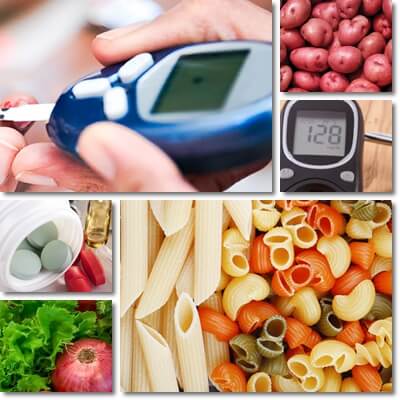Are you diabetic? Are you looking to keep your blood sugar levels under control? Then the glycemic index is a notion that you’re probably familiar with. But just how important is the glycemic index when it comes to preventing blood sugar spikes and controlling diabetes? Is the glycemic index an essential reference point when choosing what foods to eat and what foods to avoid with diabetes? What exactly is the relation between the glycemic index and diabetes? And what is the glycemic index?
What is the glycemic index?
The glycemic index is a scale that measures how foods affect blood sugar. More exactly, the glycemic index measures how fast and how much the carbohydrates in a food raise blood sugar levels. The glycemic index is designed as a numerical scale and assigns numerical values to foods based on how much they affect blood sugar. The glycemic index scale ranges from 0 to 100 – values between 0 and 55 represent a low glycemic index (GI), between 55/56 and 69 a moderate GI and between 70-100 a high GI. Low-glycemic foods affect blood sugar the least and are preferred in a generally healthy diet, while high glycemic foods affect blood sugar to great extents and are best consumed infrequently and in small amounts.

How accurate is the glycemic index?
This is a valid question to ask yourself if you are considering referring to the glycemic index for blood sugar control and diabetes management. The glycemic index is an accurate system of measurement of the glycemic impact of foods in the sense that is assigns specific numerical values to each food considered. But in reality foods are never one fixed value on the scale. Several factors can affect the glycemic index score of a food, including variety and cultivar, degree of ripeness and growing conditions, all of which directly impact the nutritional status of foods and, subsequently, the GI score.
For example, ripe fruits and overripe fruits have slightly more of an impact on blood sugar compared to unripe and underripe fruit as the ripening process coincides with a natural rise in sugar content. Some varieties of some fruits are naturally sweeter, a sign of a higher sugar content, which again, causes a slight rise in glycemic effects. So many foods are better represented by a range of values on the glycemic index score instead of one fixed value, but variations aren’t usually extreme.
Exceptions do exist however. For instance, the glycemic index of honey can range from values below 55 (even as low as 30+) which is a low GI score, to values over 70, which is a high GI. Most honeys however are somewhere between 60 and 70 on the glycemic index scale which is a moderate GI. This significant variation in the glycemic index of honey can be explained by the natural variation in the fructose vs glucose content in the honey – fructose and glucose are two simple sugars and the main sugars in honey which together account for about 80% of honey. While fructose is low-glycemic, glucose is high-glycemic so high-fructose honeys will be low glycemic while high glucose honeys will be high glycemic.

Cooking and glycemic index variations
How a food is cooked can impact its glycemic index significantly. Some foods become lower glycemic after cooking, while others become higher glycemic. Both the choice of cooking method and the ingredients used impact the glycemic score.
When you fry potatoes, sweet potatoes, bananas, plantains or any vegetable really, you add fat to their composition. Fat has no carbohydrates and doesn’t raise blood sugar levels. Moreover, fat slows down digestion and the absorption of sugar from other foods in the bloodstream. So the resulting fried food has fewer carbohydrates per serving which translates into less of a glycemic impact, and fat to slow down the absorption of the carbs it does have which means a slower rise in blood sugar levels. But because fried food is not healthy, intake should be infrequent and limited to small amounts (source).
Roasting, oven baking and boiling are known to raise the glycemic index score of foods and cause foods cooked this way to affect blood sugar to a greater extent. Roasting, baking and boiling are successful at breaking down foods to a soft, excessively tender consistency which is akin to almost already digested food. Extremely easily digestible food passes through the digestive tract a lot faster and the sugars derived from it end up in the bloodstream quicker too, resulting in a more rapid raise in blood sugar levels.
For some foods containing resistant starches, such as sweet potatoes, boiling can help achieve a lower glycemic index and reduce effects on blood sugar, studies say (source). However, other foods such as rice and grain-based products such as pasta are affected differently by boiling. Cooking pasta until very soft raises glycemic index score. But when pasta is cooked al dente, it can have a low glycemic index and may possibly slow digestion rates and contribute to lesser effects on blood sugar as well as longer satiety (source).
Even so, people process food differently so a person may experience a spike in their blood sugar levels after eating a certain food or a certain amount of a certain food, be it bread, pasta, dates, watermelon, chocolate or honey, while another person might not.
Glycemic index and diabetes
What is the relation between glycemic index and diabetes? In short, the glycemic index can be a great tool for anyone looking to manage diabetes because because it helps achieve relatively good blood sugar control. The glycemic index gives you a rough, but good idea of which foods are going to raise blood sugar levels excessively, and quickly, and helps you avoid them on a general level, or keep intakes very low or consumption infrequent. The glycemic index is also a great suggestion list of foods that are generally good to eat if you are struggling with high blood sugar or diabetes, or just looking to eat and be healthy.
What’s good about the glycemic index is that foods that are low-glycemic are also typically healthier, while foods that are high-glycemic are typically less healthy – not necessarily unhealthy, but better eaten in smaller amounts or less frequently, so you have a rough, but good idea of what to eat and what not to eat if you have diabetes or hyperglycemia.
How is the glycemic index calculated?
To determine the glycemic index of a food, the effects of an amount of a given food containing 50 g of carbohydrates are compared to the effects of 50 g of pure glucose. That is, the effects on blood sugar of 50 g of carbs from dates or chocolate or watermelon or rice are determined by measuring blood sugar levels post-meal. Then the effects on blood sugar of 50 g of pure glucose are determined the same way, by measuring blood sugar levels post-meal.
The test is done on healthy individuals who do not have diabetes or hyperglycemia (consistently high blood sugar levels) and measuring of blood sugar levels takes place within the first two hours of eating the food and the glucose serving. The simple sugar glucose is the reference point because it has the highest glycemic index score (100) and will elicit the greatest effects on blood sugar. Typically 10 subjects take part in the measurements. The score for the tested food is divided by the score of the reference food (glucose), then multiplied by 100. The resulting glycemic index value for the tested food is an average score obtained from all 10 participants.
